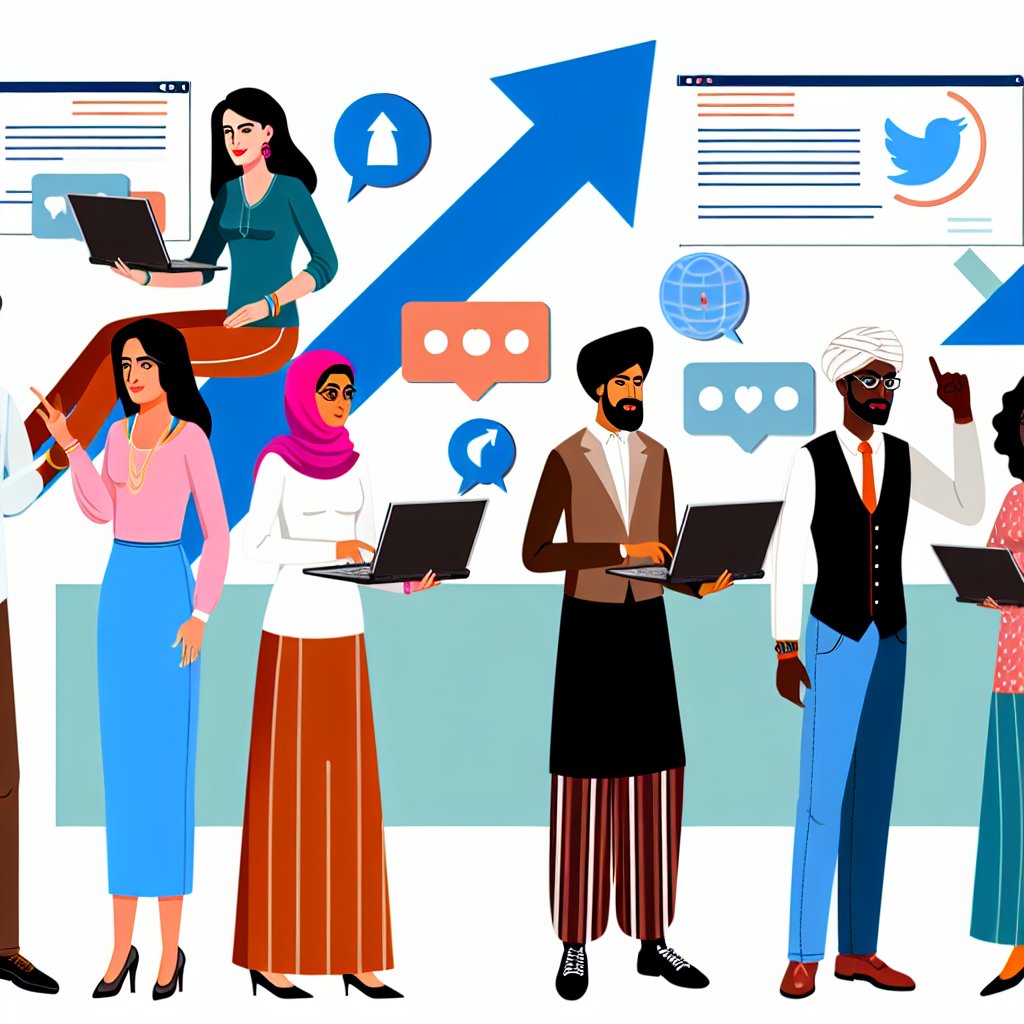Overview of Social Media Integration Software and Its Role in Streaming
Defining Social Media Integration Software
Social media integration software connects streaming platforms with social networks seamlessly.
It enables streamers to engage audiences through real-time updates and interactions.
Moreover, it consolidates social feeds and comments into a single dashboard.
This capability helps streamers monitor their audience’s reactions instantly.
Enhancing Viewer Engagement During Streams
Streamers use integration software to display live social media interactions.
Consequently, audiences feel more involved and valued throughout the stream.
For example, Twitch streamer Lucas Moreno uses it to showcase live tweets.
This approach boosts viewer participation and retention effectively.
Key Features That Empower Real-Time Interaction
Most social media integration tools offer chat aggregation from multiple platforms.
Additionally, they support custom alerts for likes, shares, and follows.
Furthermore, content moderators can manage conversations directly within the software.
These features enable streamers to maintain a positive and lively community.
Benefits for Content Creators and Audiences
Streamers gain greater control over audience communication during live sessions.
Meanwhile, viewers appreciate immediate responses and interactive content elements.
Companies like Streamline Interactive have developed intuitive platforms for this purpose.
Their tools simplify bridging gaps between content and social engagement.
Emerging Trends Influencing Streaming Interaction
Integration software increasingly incorporates AI to analyze audience sentiment.
Therefore, streamers can adapt their content based on real-time feedback.
Besides, multiplatform streaming combined with social media boosts reach dramatically.
Innovators like Horizon Media enhance these experiences with VR and AR features.
Ultimately, integration software remains vital for dynamic and engaging streaming.
Key Features of Real-Time Audience Interaction Tools in Streaming Platforms
Live Chat and Messaging
Live chat enables viewers to communicate instantly during a stream.
It creates a sense of community among participants.
Moreover, hosts can respond to questions and comments in real time.
This feature boosts engagement and keeps audiences invested.
Polls and Quizzes
Polls allow streamers to gather audience opinions quickly.
Quizzes provide an interactive way to test viewer knowledge.
Together, these tools keep content dynamic and participatory.
They also help content creators tailor streams based on feedback.
Reactions and Emojis
Viewers express emotions instantly through reactions and emojis.
This feature adds a fun visual element to conversations.
It encourages spontaneous interaction during key moments.
Consequently, streamers can gauge audience sentiment immediately.
Integrations with Social Media Platforms
Social media integration shares live content across multiple channels.
It expands the reach and attracts diverse audiences.
Put Your Tech Company on the Map!
Get featured on Nicholas Idoko’s Blog for just $50. Showcase your business, boost credibility, and reach a growing audience eager for tech solutions.
Publish NowAdditionally, creators can monitor engagement from various platforms in one place.
This streamlines communication and enhances marketing efforts.
Customizable Alerts and Notifications
Alerts notify streamers about important viewer actions.
They may signal new followers, donations, or chat messages.
Customizing notifications helps maintain smooth and timely interactions.
Furthermore, it keeps both hosts and audiences connected seamlessly.
Audience Analytics and Insights
Analytics provide valuable data on viewer behavior and preferences.
These insights help content creators improve future streams.
Hence, streamers can make data-driven decisions to boost engagement.
Ultimately, analytics foster stronger connections with the audience.
Technologies Enabling Seamless Social Media Integration for Live Streams
Application Programming Interfaces (APIs)
APIs facilitate smooth data exchange between social media platforms and streaming software.
They enable developers to access real-time comments, likes, and shares from viewers.
For instance, Twitch and YouTube offer robust APIs for extracting live chat data.
Moreover, these APIs allow streamers to publish updates directly to social channels.
Consequently, APIs form the backbone of social media integration software.
WebSocket Technology
WebSocket enables continuous two-way communication between clients and servers.
This technology is essential for delivering instant audience interactions during live streams.
Unlike traditional HTTP requests, WebSocket maintains an open connection.
Therefore, it reduces latency and improves the responsiveness of chat overlays.
Popular platforms like StreamLabs use WebSocket to push live social media updates.
Natural Language Processing (NLP) and Sentiment Analysis
NLP processes audience comments to extract meaningful insights during streams.
It helps identify trending topics, questions, and sentiments in real time.
Streamers can use sentiment analysis to gauge viewers’ reactions instantly.
Furthermore, NLP-powered chatbots can moderate conversations and respond automatically.
These features enhance interaction quality and audience satisfaction.
Cloud Computing and Edge Servers
Cloud computing provides scalable infrastructure to handle social media data streams.
It enables dynamic resource allocation during sudden audience spikes.
Edge servers reduce data transmission delays by processing information closer to viewers.
This setup ensures smoother and more reliable social media integration.
Companies like HexaStream host their integration services on distributed cloud networks.
Real-Time Data Visualization Tools
Data visualization software transforms social media metrics into engaging overlays.
These tools display live polls, follower counts, and hashtag trends seamlessly.
Streamers benefit from customizable widgets that update instantly during broadcasts.
Consequently, viewers stay more engaged through dynamic visual feedback.
Custom visualizations improve both entertainment value and audience interaction.
Put Your Tech Company on the Map!
Get featured on Nicholas Idoko’s Blog for just $50. Showcase your business, boost credibility, and reach a growing audience eager for tech solutions.
Publish NowCross-Platform Integration Frameworks
Integration frameworks simplify connecting multiple social media accounts with streaming apps.
They support platforms such as Instagram, Facebook, Twitch, and Twitter simultaneously.
This capability broadens reach and fosters a diverse online community.
Frameworks often include authentication protocols to secure account connections.
Hence, streamers can manage all social interactions from a unified interface.
Explore Further: AI-Powered Lighting Design Tools: Enhancing Stage and Event Ambiance
Benefits of Integrating Social Media Channels for Enhanced Viewer Engagement
Expanding Audience Reach
Integrating social media channels broadens a streamer's audience significantly.
For example, platforms like Twitter and Instagram attract diverse user groups.
This expansion exposes content to viewers who might not find it otherwise.
Moreover, seamless sharing increases organic growth and brand recognition.
As a result, creators like Lucas Harper have rapidly grown their viewer base.
Real-Time Interaction and Feedback
Social media integration allows instant communication during live streams.
This immediacy helps streamers respond directly to viewer comments.
Consequently, the interaction feels more personal and engaging.
Streamers such as Elena Thompson leverage this to keep audiences involved.
Additionally, quick feedback helps adjust content to viewer preferences instantly.
Enhancing Community Building
Connecting social media channels fosters stronger communities around content.
Fans can interact not only with creators but also with each other.
This interaction nurtures loyalty and increases viewer retention rates.
Furthermore, social media events promote collaboration and shared experiences.
For instance, gamer Derek Molina uses integrated chats to unite his followers.
Boosting Content Promotion and Visibility
Sharing stream highlights and announcements on various platforms increases visibility.
Platforms like Facebook and LinkedIn help reach both casual viewers and professionals.
Targeted promotions draw more viewers to upcoming streams.
Hence, creators like Maya Chen experience consistent audience growth.
Also, cross-platform campaigns generate buzz and anticipation effectively.
Enabling Data-Driven Insights
Integrated tools provide valuable analytics about audience behavior.
Streamers receive data on engagement rates, peak view times, and demographics.
These insights allow content creators to tailor streams better to their audience.
For example, analytics helped Carlos Rivas optimize his streaming schedule.
Thus, social media integration supports smarter content and marketing decisions.
Improving Monetization Opportunities
Integrated social media enhances promotional avenues for sponsorships and ads.
Streamers can showcase partnerships directly within streams and posts.
This visibility attracts brands looking for interactive marketing.
Moreover, platforms like TikTok and YouTube shorts help monetize short content.
Put Your Tech Company on the Map!
Get featured on Nicholas Idoko’s Blog for just $50. Showcase your business, boost credibility, and reach a growing audience eager for tech solutions.
Publish NowConsequently, influencers like Priya Das increase income through multi-channel presence.
Streamlining Workflow and Content Management
Using unified software simplifies managing multiple social media accounts.
Creators save time by scheduling posts and moderating comments centrally.
This efficiency allows more focus on creating quality content for viewers.
Streamers such as Nathaniel Brooks benefit from reducing multitasking stress.
Ultimately, integration tools enhance productivity and viewer engagement simultaneously.
Delve into the Subject: Virtual Production Studios: How Software is Transforming Set Design
Challenges and Solutions in Implementing Real-Time Interaction Software
Latency and Performance Issues
Real-time interaction software must process data with minimal delay.
However, network latency often disrupts streaming integration.
Additionally, high traffic volumes cause server overloads frequently.
To address these challenges, developers optimize data pipelines aggressively.
Moreover, edge computing helps by processing interactions closer to users.
Companies like Streamline Technologies implement CDN strategies effectively.
These techniques reduce lag and improve responsiveness consistently.
Integration with Multiple Social Media Platforms
Integrating diverse social media APIs poses compatibility challenges.
Different platforms have varying data formats and rate limits.
Furthermore, frequent API changes require continuous updates to software.
Developers use abstraction layers to standardize interactions across platforms.
Consequently, this reduces maintenance costs and improves stability.
Teams at InteractiveWave specialize in creating such flexible integration layers.
They ensure seamless communication with Facebook, Twitter, and TikTok APIs reliably.
Moderation and Content Filtering
Real-time user interactions can introduce inappropriate or harmful content.
Effective moderation is crucial to maintain a positive streaming environment.
Automated filters employing AI detect offensive language rapidly.
However, these filters sometimes produce false positives or miss subtle abuse.
Therefore, hybrid models combining AI and human moderators perform best.
LiveStream Dynamics uses this approach to ensure safe engagement.
They empower moderators with tools to quickly review flagged interactions.
Scalability for Large Audiences
Streaming platforms often face unpredictable audience sizes during live events.
Software must scale dynamically to handle millions of concurrent interactions.
Static server infrastructure cannot meet these sudden spikes efficiently.
Cloud-based architectures using auto-scaling resolve this issue elegantly.
Solutions from NimbusTech auto-provision resources as needed immediately.
This flexibility ensures uninterrupted interaction even during high demand.
Moreover, load balancing distributes requests evenly across servers successfully.
Put Your Tech Company on the Map!
Get featured on Nicholas Idoko’s Blog for just $50. Showcase your business, boost credibility, and reach a growing audience eager for tech solutions.
Publish NowEnsuring Data Privacy and Security
Real-time interaction tools collect substantial user data during streaming.
Protecting this information against breaches is a paramount concern.
End-to-end encryption safeguards interactions from interception effectively.
Additionally, compliance with GDPR and other regulations is mandatory.
Auditing mechanisms monitor access and usage patterns continuously.
Innovatech Solutions leads in deploying robust security measures for clients.
They build trust by prioritizing user privacy in their software designs.
See Related Content: NFT Creation Software for Digital Artists in the Entertainment Industry
Case Studies of Successful Social Media Integration in Popular Streaming Services
Twitch’s Real-Time Chat Experience
Twitch excels at combining live streaming with interactive chat features.
The platform integrates social media elements by allowing viewers to react instantly.
Streamers leverage this integration to build tight-knit communities.
Moreover, Twitch’s chat bots automate engagement and provide timely responses.
This constant interaction increases viewer retention and satisfaction.
YouTube Live’s Interactive Polls and Super Chats
YouTube Live enhances audience involvement through built-in polling and donation tools.
Creators can engage viewers in decision-making during broadcasts.
These features encourage fans to participate actively throughout streams.
Additionally, YouTube integrates notifications across social platforms to boost viewership.
Consequently, creators experience greater reach and real-time feedback.
Facebook Gaming’s Social Sharing Features
Facebook Gaming incorporates social media sharing seamlessly within streams.
Viewers can recruit friends by sharing live sessions on their timelines.
This sharing results in viral growth and increased audience engagement.
Furthermore, Facebook’s reactions and comments enhance viewer-streamer communication.
Such integration fosters a more dynamic and communal streaming environment.
Netflix’s Social Media Tie-Ins for Interactive Shows
Netflix experiments with social media elements in interactive content like “Bandersnatch.”
Viewers discuss plot choices on Twitter and Instagram, enriching the experience.
Netflix actively monitors these conversations to gauge audience sentiment.
This approach creates a feedback loop that drives content improvements.
Therefore, Netflix blends streaming with social engagement effectively.
Effective Strategies Derived from Social Media Integration Case Studies
- Enable real-time audience interaction through chats, polls, or reactions.
- Incorporate social sharing tools to amplify stream visibility.
- Use social media insights to tailor content dynamically.
- Develop community-focused features that promote viewer loyalty.
- Leverage automated tools for timely and personalized engagement.
Explore Further: AI Voice Cloning for Actors: The Future of Dubbing and Voiceovers

Designing User-Friendly Interfaces for Audience Interaction During Live Streams
Prioritizing Intuitive Navigation and Accessibility
Streamlining interface design enhances the user experience for all audience members.
Designers focus on clear menus and straightforward controls.
This simplicity allows viewers to engage without confusion or frustration.
Accessible designs accommodate users with disabilities effectively.
Offering keyboard navigation supports individuals with limited mobility.
Color contrast and font size adjustments improve readability for everyone.
Put Your Tech Company on the Map!
Get featured on Nicholas Idoko’s Blog for just $50. Showcase your business, boost credibility, and reach a growing audience eager for tech solutions.
Publish NowEnhancing Real-Time Engagement with Interactive Features
Incorporating live polls encourages viewers to participate actively during streams.
Chat boxes enable instant conversations between audiences and streamers.
Reaction buttons provide quick feedback without disrupting the experience.
These features keep viewers involved and contribute to dynamic interactions.
Optimizing Performance and Responsiveness
Interfaces must load quickly to maintain audience attention during live events.
Developers minimize heavy graphics and optimize code efficiency.
This approach prevents lag and ensures smooth interactions at all times.
Responsive designs adapt seamlessly to desktops, tablets, and smartphones.
Users enjoy consistent experiences regardless of their device choice.
Incorporating Personalization and Customization Options
Allowing users to tailor their interface enhances comfort and engagement.
Customizable themes let viewers select colors and layouts that suit them best.
Adjustable notification settings prevent overwhelming alerts.
Such options empower audiences and foster longer, more meaningful interactions.
Gathering User Feedback and Testing for Continuous Improvement
Conducting usability tests reveals areas needing refinement in the interface.
Feedback loops with real users highlight practical issues and preferences.
Developers iterate designs based on collected insights and analytics.
This ongoing process ensures the interface evolves to meet audience demands effectively.
Analytics and Data Insights Derived from Social Media Interactions in Streaming
Real-Time Audience Engagement Metrics
Social media integration software captures detailed engagement metrics instantly.
These metrics include likes, shares, comments, and viewer reactions.
Streaming platforms then analyze this data to gauge audience mood and interest.
Moreover, real-time feedback helps streamers adjust content dynamically.
For example, a spike in comments can indicate increased viewer involvement or curiosity.
Audience Demographics and Behavior Analysis
The software aggregates demographic data such as age, location, and language.
This information provides broadcasters a clearer picture of their audience composition.
Furthermore, understanding behavior patterns allows for targeted content strategies.
For instance, peak viewing times can be identified to optimize streaming schedules.
Additionally, repeated interaction patterns reveal loyal viewer segments.
Sentiment Analysis and Viewer Feedback
Advanced tools use natural language processing to determine sentiment from comments.
This analysis distinguishes positive, neutral, and negative viewer responses.
As a result, streamers can evaluate which segments resonate well with audiences.
Also, constructive criticism can be quickly identified and addressed.
Consequently, sentiment insights improve content quality and viewer satisfaction.
Performance Tracking and Growth Measurement
Integrated analytics track key performance indicators over time.
These KPIs include viewer retention, average watch time, and share rates.
Streamers and marketers use these insights to measure channel growth effectively.
Put Your Tech Company on the Map!
Get featured on Nicholas Idoko’s Blog for just $50. Showcase your business, boost credibility, and reach a growing audience eager for tech solutions.
Publish NowThey also pinpoint strategies that attract and retain larger audiences.
Therefore, data-driven decisions promote sustainable audience development.
Benefits for Content Creators and Marketers
Access to rich social media data enhances content personalization and relevance.
Marketers leverage these insights to launch more effective ad campaigns.
Additionally, creators can build stronger community connections through tailored interactions.
This leads to higher engagement rates and increased brand loyalty.
Ultimately, real-time analytics empower continual improvement in streaming experiences.
Future Trends in Social Media Integration and AI-Driven Audience Engagement
Advancements in Real-Time Social Media Integration
Social media platforms continuously evolve to enhance user interaction.
Streaming software must integrate these platforms seamlessly.
Developers like Meridian Streams are innovating solutions for real-time social media data.
These solutions enable creators to respond instantly to audience feedback.
Cross-platform integration increases the reach of live streams.
Tools such as StreamSync allow broadcasters to connect multiple social media accounts.
This broad connectivity fosters a more interactive viewer experience.
Artificial Intelligence Enhancing Audience Engagement
AI powers smarter analysis of audience sentiment during live streams.
Natural language processing helps interpret comments and reactions rapidly.
Companies like NeuralCast utilize AI to generate personalized responses in chats.
This technology keeps audience members engaged and valued in real time.
Additionally, AI-driven content recommendations adapt stream elements to viewer preferences.
For example, Hawthorne Media uses machine learning to tailor graphics and polls dynamically.
Such interactivity significantly improves viewer retention rates.
Emerging Technologies Shaping Interaction Dynamics
Beyond AI, augmented reality (AR) is transforming viewer participation.
Streamers can overlay interactive AR elements responding to audience input.
VividEngage has developed AR tools that integrate with Twitch and YouTube streams.
This feature encourages viewers to influence the streaming environment actively.
Moreover, blockchain technology presents new opportunities for transparent audience rewards.
Platforms like ChainStream enable tokenized incentives for active participation.
These innovations collectively redefine the social experience of live streaming.
Advancing Personalization and Immersive Engagement for Streamers and Audiences
Future streaming platforms will prioritize personalized and immersive interactions.
Streamers will leverage AI to anticipate audience needs proactively.
Audiences will enjoy a seamless blend of social and entertainment elements.
Companies like Aurora Live are pioneering these forward-thinking integration models.
Social media integration software will become more intuitive and adaptive.
This progress will deepen the connection between creators and their communities.
Security and Privacy Considerations in Real-Time Social Media Interaction Software
Protecting User Data
Real-time social media integration software processes vast amounts of user data continuously.
Put Your Tech Company on the Map!
Get featured on Nicholas Idoko’s Blog for just $50. Showcase your business, boost credibility, and reach a growing audience eager for tech solutions.
Publish NowTherefore, protecting this sensitive information must be a top priority for developers.
Encryption protocols such as TLS and AES help safeguard data during transmission and storage.
Additionally, software should limit data access to authorized personnel only.
Implementing role-based access control reduces the risk of unauthorized data exposure.
Regular security audits identify potential vulnerabilities before attackers exploit them.
Ensuring Compliance with Privacy Regulations
Adhering to global privacy laws is essential when handling real-time social media interactions.
Software providers must comply with GDPR, CCPA, and other relevant data protection standards.
Moreover, transparency about data collection and usage builds user trust.
Consent mechanisms should be clear and easy to navigate for all users.
Regular updates to privacy policies reflect changes in regulatory requirements effectively.
Companies like Talon Media Solutions update their compliance frameworks quarterly.
Mitigating Risks of Data Breaches
Real-time interaction platforms face significant risks related to data breaches.
Thus, integrating multi-factor authentication enhances security for user accounts.
Continuous monitoring systems detect suspicious activities before they cause harm.
Incident response plans ensure swift action if a breach occurs.
Training staff on cybersecurity best practices reduces human error-related vulnerabilities.
For example, Northstar Interactive enforces strict access policies and incident drills.
Securing Third-Party Integrations
Many social media integration tools connect with external APIs and services.
Consequently, their security posture affects the overall system integrity.
Vetting third-party partners rigorously minimizes supply chain risks.
Developers should use secure API authentication methods such as OAuth 2.0.
Regularly updating and patching integrations prevents exploitation of known flaws.
In addition, logging API activity helps trace and resolve security incidents quickly.
Balancing Real-Time Performance with Security Measures
Implementing security can sometimes impact the responsiveness of real-time systems.
Nevertheless, it is crucial to balance performance and protection effectively.
Optimizing encryption algorithms ensures minimal latency during data exchange.
Edge computing can reduce data transmission to central servers, enhancing speed and privacy.
Testing and refining these approaches allow platforms like StreamLink Solutions to excel.
Ultimately, maintaining this balance supports a secure and engaging user experience.
Additional Resources
Social Media in Sports: Driving Fan Engagement I Greenfly
ACCC+commissioned+report+-+The+impact+of+digital+platforms+ …
Before You Go…
Hey, thank you for reading this blog post to the end. I hope it was helpful. Let me tell you a little bit about Nicholas Idoko Technologies.
We help businesses and companies build an online presence by developing web, mobile, desktop, and blockchain applications.
We also help aspiring software developers and programmers learn the skills they need to have a successful career.
Take your first step to becoming a programming expert by joining our Learn To Code academy today!
Put Your Tech Company on the Map!
Get featured on Nicholas Idoko’s Blog for just $50. Showcase your business, boost credibility, and reach a growing audience eager for tech solutions.
Publish NowBe sure to contact us if you need more information or have any questions! We are readily available.
[E-Books for Sale]
1,500 AI Applications for Next-Level Growth: Unleash the Potential for Wealth and Innovation
$5.38 • 1,500 AI Applications • 228 pages
Are you ready to tap into the power of Artificial Intelligence without the tech jargon and endless guesswork? This definitive e-book unlocks 1,500 real-world AI strategies that can help you.
See All 1,500 AI Applications of this E-Book
750 Lucrative Business Ideas: Your Ultimate Guide to Thriving in the U.S. Market
$49 • 750 Business Ideas • 109 pages
Unlock 750 profitable business ideas to transform your future. Discover the ultimate guide for aspiring entrepreneurs today!
See All 750 Business Ideas of this E-Book
500 Cutting-Edge Tech Startup Ideas for 2024 & 2025: Innovate, Create, Dominate
$19.99 • 500 Tech Startup Ideas • 62 pages
You will get inspired with 500 innovative tech startup ideas for 2024 and 2025, complete with concise descriptions to help you kickstart your entrepreneurial journey in AI, Blockchain, IoT, Fintech, and AR/VR.
We Design & Develop Websites, Android & iOS Apps
Looking to transform your digital presence? We specialize in creating stunning websites and powerful mobile apps for Android and iOS. Let us bring your vision to life with innovative, tailored solutions!
Get Started Today





